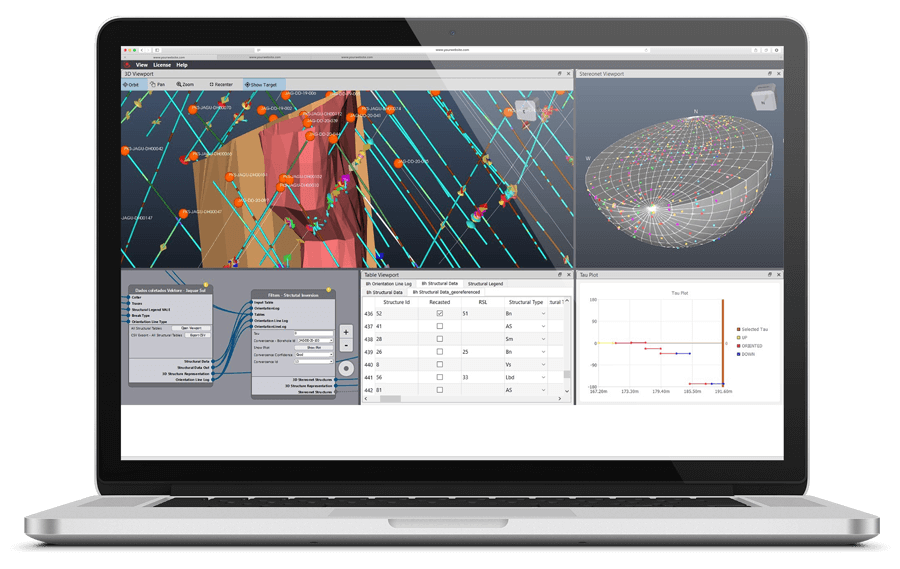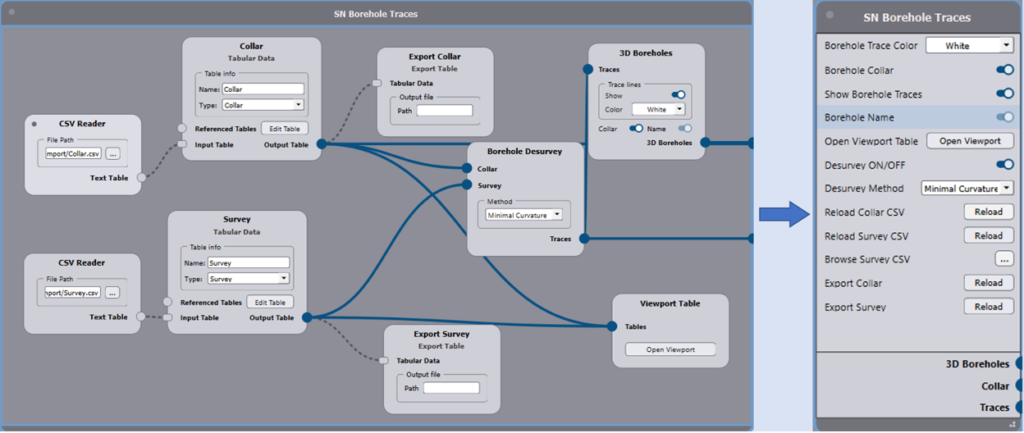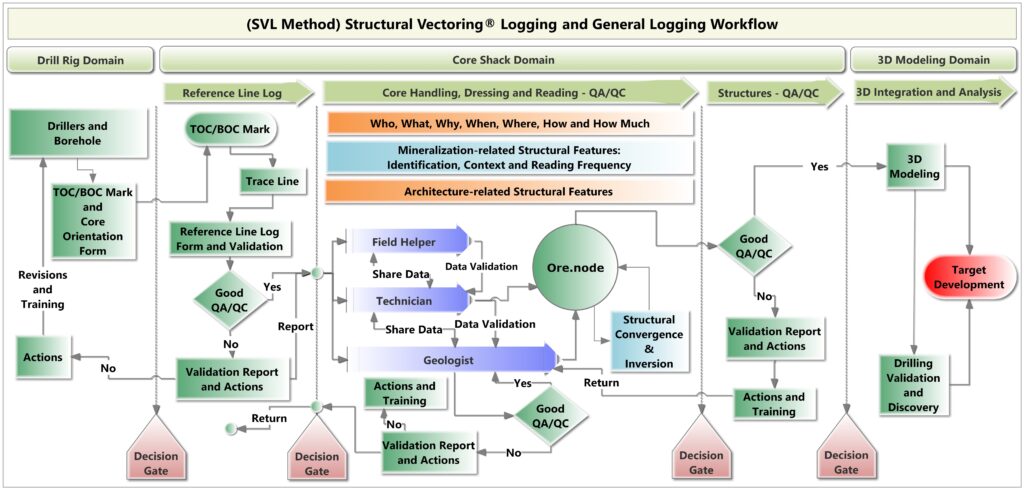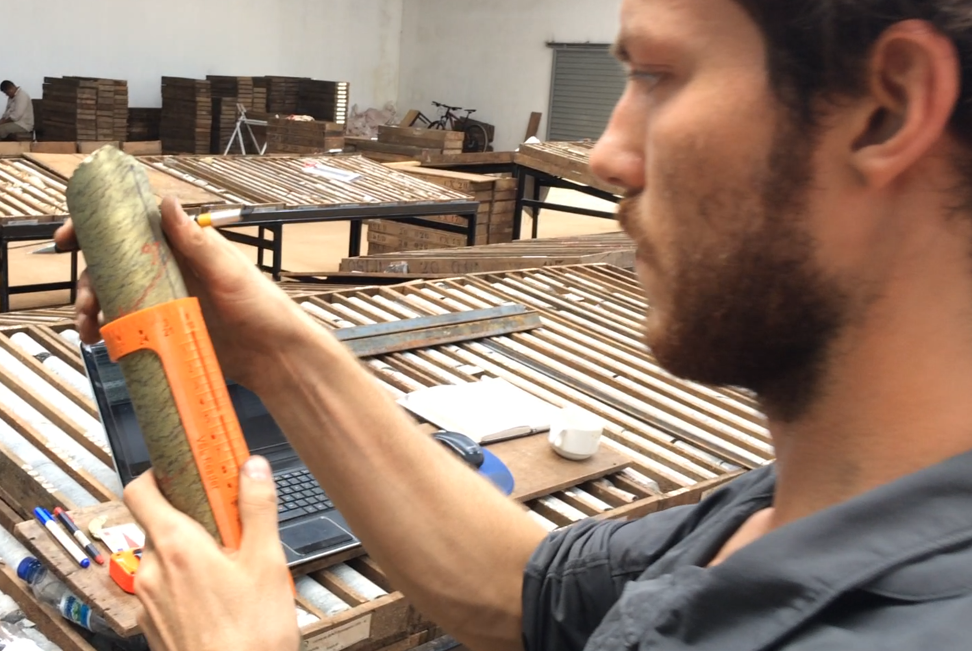The Ore.node software is a 3D, real-time visualization tool built for project geologists at drilling and core logging facilities, that combines general and structural logging to generate high quality data – this allows for decisions to be made faster and confidently.
Ore.node

Currently, visualization of general and structural logging are tasks generally performed by geo-modelers – normally standing away from the core and outcrops. We believe that data and visualization must be available from the very beginning, not later in the process when data is hard to validate.
With the goal of bringing a visualization tool to project geologists at the drilling and core logging facilities, we have engineered Ore.node, a real-time, 3D visualization, innovative workflow-based user interface software that combines general logging with our innovative structural geology module. Ore.node was designed by structural economic geologists, 3D geo-modelers and highly trained core loggers, for project geologists.
Ore.node handles any type of lineation, fold vergence, facing, flow sense, way-up and kinematic analysis on full, one-half and one-quarter core, creating the appearance of logging an outcrop. Specialized modules such as Structural Vectoring® – Inversion and Convergence, allow analysis and re-orientation of non-oriented or improperly oriented core. Its easy-to-understand 3D stereonet optimizes structural logging analysis. Ore.node also promotes information exchange among exploration geologists and decision-makers by using its customizable workflows to suit different levels of interest and expertise.

Vektore will be delighted to share with you this exciting development. Trials will be provided to interested exploration companies!
Nodes are the building blocks of workflows and they are customizable virtual containers that load and process data allowing data interactions amongst nearby connected nodes. These virtual containers are not transient, such as menus and icons – they are persistent in the workflow. They have ports, which allow data input or output, and are linked by connectors, the nodes’ highways, in which processes and data/information are transferable amongst nodes of various styles. Groups of connected nodes with common tasks are segmented into containers – the Supernodes.
Ore.node is a node-based paradigm software that allows users to bring in and process data interactively within its workflow space. These workflows have the following properties:
- Automation: small changes are passed down the chain of operations of a given workflow; it frees up users to focus on the actual work
- Persistence: workflows are persistent and not transient such as menu-based software; each step can be later investigated and modified to achieve a particular goal
- Reusability: users can reuse and share small or large and complex workflows
- Repurposing: by changing inputs and/or a few parameters, users can obtain different, although highly controlled, results
- Parallelism: workflows can be duplicated and set in parallel to test competing hypothesis
- Horizontalization: workflows can be shared amongst peers to leverage their knowledge base
- Verticalization: workflows can also be pre-formatted to offsite management to provide them with proper information for the understanding of projects under their supervision
- Scalability: it is capable of modeling simple and/or extremely complex and layered processes

Innovative Structural Vectoring Methods Embedded into Ore.node
Structural Vectoring Logging (SVL) Method
Designed to overcome limitations of industry-standard methods, SVL allows for fast, accurate handling of any type of lineation (on and off-plane), including fold vergence, facing, flow sense, way-up and kinematics from oriented and non-oriented cores
SVL encompasses three distinct domains: Drill Rig, Core Shack and 3D Modeling. The Core Shack domain is further divided into three subdomains: Reference Line Log, Core Dressing and Reading, and Structures QAQC. The centerpiece of the SVL method is at the Core Shack Domain, while providing a solid bridge to transfer data and information between the Drill Rig and the 3D Modeling.
The SVL method includes Vektore’s proprietary method of reading structural features from oriented and non-oriented core, the SVL reading method, which was developed in 2002 (Monteiro, 2002 – intellectual property of Rogerio Monteiro). The SVL reading method was developed to overcome the reading limitations of the current industry-standard alpha-beta-gamma, in particular, while handling lineations and their attributes. The SVL Reader, which is a 3D printed tool is used to read the structures from the core. The SVL method has been ported into the Ore.node software. The SVL reading method is user-friendly, accurate/precise and fast. It handles any type of lineation (on and off-plane), including fold vergence, facing, flow sense, way-up and kinematics. It reads from full, one-half and one-quarter core – it treats core as if it were an outcrop. The figure below presents the various stages or domains predicted by the method and their relationships while porting information from one domain to the other. Gates are key to maintaining good quality of data and good usage.


Structural Vectoring Convergence Method
To recast reference line mismatches noted amongst a sequence of core orientation intervals, this module converges sets of reference lines into one internally consistent interval based on given interlocking angles (Tau) and at the same time, repositions the structural data accordingly
Mismatches between adjacent core orientation runs that have their core pieces locked is quite a common problem found in core orientation programs. We have found cases where only 20% of all oriented core intervals with locking core pieces present good matches (Tau smaller than ±15°). Structural Convergence addresses this significant problem.
Structural Vectoring Convergence Readiness Sub-method
A module in which users are trained to complete the Reference Line Log table, and along with the Drillers Core Orientation table, set the structural logging process properly
The Reference Line Log holds all information required for the user to proceed with Structural Convergence. The Structural Vectoring Convergence method has been ported into the Ore.node software and it carries out the process in real time provided the Reference Line Log table is available while structural logging is carried out.
Structural Vectoring Inversion Method
Used for re-orienting non-oriented or quasi-oriented core based on the architecture of the drilling target enabling early target architecture evaluation and drilling re-direction
This method comes with 3D stereonet eigen-statistics and a visual framework to guide the process of inversion. It uses a robust algebraic algorithm to recast the likely orientation of key structural mineralization vectors, allowing for otherwise not possible, significant geometrical predictions. It is a reliable new method to create sound structural scenarios enabling geologists to better evaluate, early on, the architecture of the target and properly re-direct drilling.
Structural Vectoring Inversion Readiness Sub-method
A training method module in which users are familiarized with the process of preparing and logging the interval candidate for Structural Vectoring Inversion
Pre-emptive locking, or setting a reference line covering the whole interval, is the best practice when intersecting mineralization by non-oriented core, while the extraction of the structures could be carried out at a later stage. The Structural Inversion Method has been ported into the Ore.node software and it carries out the process in real-time provided the Reference Line Log table is available while structural logging is carried out.
Structural Vectoring Convergence and Inversion can be run isolated, in series, or in parallel to achieve the best results.